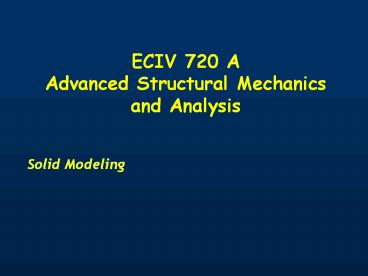ECIV 720 A Advanced Structural Mechanics and Analysis - PowerPoint PPT Presentation
1 / 67
Title:
ECIV 720 A Advanced Structural Mechanics and Analysis
Description:
ECIV 720 A Advanced Structural Mechanics and Analysis Solid Modeling Summary of Procedure Summary of Procedure Summary of Procedure Summary of Procedure Summary of ... – PowerPoint PPT presentation
Number of Views:275
Avg rating:3.0/5.0
Title: ECIV 720 A Advanced Structural Mechanics and Analysis
1
ECIV 720 A Advanced Structural Mechanics and
Analysis
- Solid Modeling
2
Summary of Procedure
T
Nodes should be placed at
3
Summary of Procedure
For Every Element Compute
- Strain-Displacement Matrix B
4
Summary of Procedure
- Node Equivalent Body Force Vector
- Node Equivalent Traction Vector
5
Summary of Procedure
Collect ALL Point Loads in Nodal Load Vector
6
Summary of Procedure
Form Stiffness Equations
7
Summary of Procedure
Apply Boundary Conditions
For Every Element Compute Stress
8
Modeling Issues
- Data Preparation
- The three modes of typical FE software
- Pre-Processing
- Processing
- Post-Processing
- Solid Modeling
- Meshing
- Solution Convergence
9
Data Processing
For a given physical problem select an
appropriate mathematical model e.g.
10
Set Up General Model Data
Material Material Properties Properties Properties Properties
No Name E v r .
id Banana xxx xxx xxx xxx
Section Section Properties Properties Properties Properties
No Name A Ix Iy .
id Apple xxx xxx xxx xxx
Constants Constants Properties Properties Properties Properties
No Name P1 P2 P3 .
id Orange xxx xxx xxx xxx
11
Set Up General Model Data
Element Groups Element Groups Options Properties Properties Properties
No Type Mat Sec Thk
1 1D Axial Tension id id n/a
2 1D Axial id id n/a
3 2D CST Plane stress id id id
4 2D CST Plane strain id id n/a
12
Finite Element Mesh
May be Defined in
Direct Way
Solid Modeling approach
- Nodes
- Elements
- Loads
- BC
- Geometry of Solid
- Loads
- BC
Automatic Mesh Generation
13
Direct FEM Mesh
Manually define nodes, elements, BC loads
14
Direct FEM Mesh
Typical Input Data (Text File or GUI) Actual
depends on software
15
Direct FEM Mesh
16
Solid Modeling
Describe Geometry of FE Domain as a collection of
Primitive Entities
17
Solid Modeling
Do not confuse with FEM node
Line
Any two points define a line
Points belong to line
18
Solid Modeling
Surface
Any closed loop of lines define surface
Points belong to lines
Points AND lines belong to surface
2 faces are defined
19
Solid Modeling
Volume
Any closed loop of faces defines volume
Points belong to lines
Points AND lines belong to surface
Points AND lines AND Surfaces belong to volume
20
Solid Modeling
Primitive Entities can be used to form
more complex solid geometries
Boolean Operations
21
Solid Modeling
Boolean Operations
22
Solid Modeling
Each of the primitive or the derived entities
(objects) is assigned a set of properties such as
material, FEM type, etc.
Typically, derived objects inherit properties of
parents. At any point, such properties can be
changed
23
Solid Modeling
Loads and Boundary Conditions can now be applied
on primitive objects regardless of the specific
Finite Elements.
24
Automatic Meshing
Solid Model
Structured Mesh (Mapped)
Free Mesh
Triangulation Techniques
Based on Geometric Transformations
25
Structured Mesh
26
Structured Mesh
27
Free Mesh
Triangulation Technique
Suitable for arbitrary geometries
28
Example Using ANSYS
thickness1
10
10
Plane Stress With Thickness E29x106
5
5
29
Define Element Groups
30
Define Element Options
31
Define Thickness
32
Define Material
33
Define Key points
34
Defining Areas
35
Deleting Entities
36
Automatic Meshing - Coarse
37
Applying Boundary Conditions
38
Applying Loads
39
Applying Loads
40
Processing
41
Deformed Shape
42
Vertical Displacement
43
sx
44
sy
45
Medium Mesh
46
Vertical Displacement
Uy 0.002042 in
Compare to Uy 0.001905 in
47
sx sy
48
Refine Mesh
49
Refined Mesh
50
Displacement Uy
51
sx sy
52
Very Fine Mesh With Element Refinement
53
Vertical Displacement
Uy 0.002084 in
Compare to Uy 0.002042 in Uy 0.001905 in
54
Stress Concentration
55
Stress Concentration
56
sx
57
sy
58
(No Transcript)
59
(No Transcript)
60
(No Transcript)
61
(No Transcript)
62
(No Transcript)
63
(No Transcript)
64
COMMON MISTAKES
Data Input
- Material properties are zero in elements that
share a node - One or more structure nodes are not connected to
an element - One or more parts of the structure are not
connected to the remainder - Unspecified or inadequate boundary conditions
65
COMMON MISTAKES
Data Input
- A spurious mode (mechanism) is possible because
of inadequate connections - Too many releases prescribed at a joint
- Large stiffness differences
- Part of the structure has buckled
- In nonlinear analysis, supports or connections
have reached zero stiffness (part of structure
inadequatly supported)
66
COMMON MISTAKES
Results appear correct
- Elements are of the wrong type (shell elements
used where solid elements required) - Mesh is too coarse or element capability too
limited - Loads are wrong in location, type or direction
- Boundary conditions are wrong in location type or
direction - Decimal points misplaced or mixed units used
67
COMMON MISTAKES
Results appear correct
- Element may be defined twice

